ACS Spring 2024
Join us at the American Chemical Society (ACS) Spring 2024 meeting, where scientists from PNNL will be presenting the latest research in chemistry and materials.
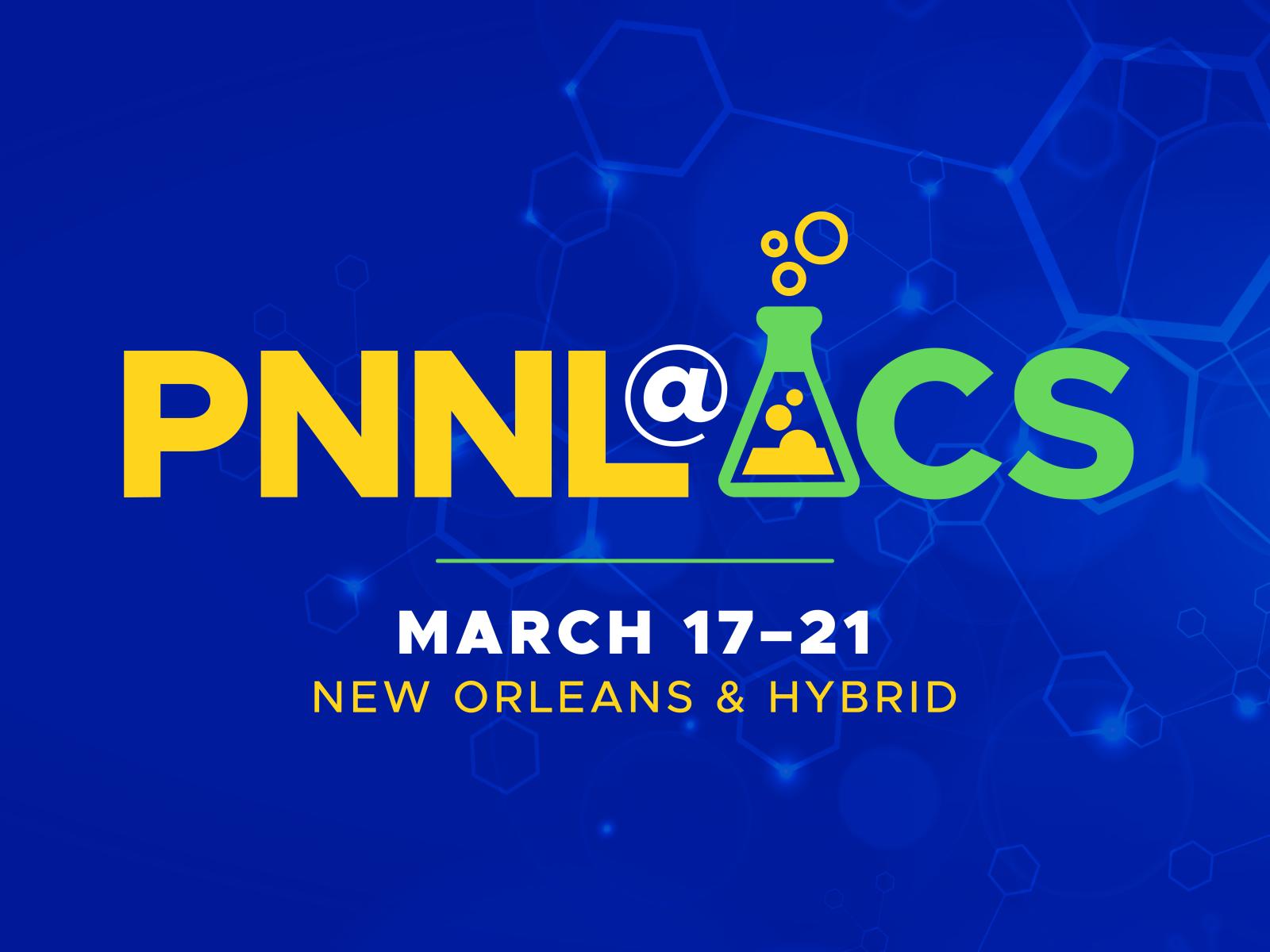
Join PNNL at ACS Spring 2024
(Image by Donald Jorgensen | Pacific Northwest National Laboratory)
Many Flavors of Chemistry, the theme of the American Chemical Society (ACS) Spring 2024 conference, features a mix of hybrid, in-person, and live virtual sessions, along with keynote events, expo hours, and poster events.
Visit Pacific Northwest National Laboratory (PNNL) at ACS Spring 2024 at booth # 2614.
Many researchers from PNNL will be participating in this year's conference. View the list of some featured presentations below.
Key Sessions
- Chemist Deepika Malhotra wins the Kavli Foundation Emerging Leader in Chemistry Award for carbon capture research. Keynote Lecture on “The Many Flavors of Carbon Capture Technologies” (March 18). READ MORE
- Physical and Computational Sciences Director of the Program Development Office, Karl Mueller, will be presenting a Thought Leadership Session with Microsoft’s Nathan Baker, previously of PNNL, on PNNL’s recent collaboration with Microsoft (March 18). READ MORE
- ACS Division of Inorganic Chemistry Award for Undergraduate Research awarded to Computational Scientist Samantha Johnson for her mentorship of Post Bachelor’s Research Associate Wilma Rishko. READ MORE
- Presentations by members of the Computational and Theoretical Chemistry Institute @PNNL and the Center for AI @PNNL, including Chemical Research Engineer Mariefel Olarte and Data Scientist Sutanay Choudhury. (March 18 and March 19)
- Progress in Mass Spectrometry: Unambiguous Identification for Small Molecules symposium organized by Chemists Robert Ewing and Yehia Ibrahim, Biomedical Scientist Thomas Metz, Computational Scientist Simone Raugei, and Biological Sciences Division Director Bobbie-Jo Webb-Robertson. (March 17 and March 18)
If you're a chemist interested in working at PNNL, check out our current openings:
For more information about physical and computational sciences at PNNL, please view these flyers.
Selected PNNL Presentations and Symposia
View a list of all PNNL's ACS Spring 2024 presentations.
Sunday, March 17
Colloidal Forces: Connecting Molecular to Macroscopic Scales
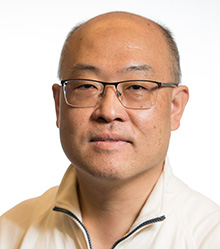
8:00 – 10:20 am and 2:00 – 4:20 pm CT, Location: Room 240
Organizer: Jaehun Chun (presider)
Summary: Colloidal forces are a subject of interest not only for understanding the fundamental mechanisms of crystal growth and self-assembly processes, but also for designing food products, paints, and adequate nuclear waste treatment processes. Colloidal forces result from phenomena at a wide range of length scales, encompassing molecular to macroscopic scales. The multi-scale nature of the colloidal forces is further impacted by additional complexity of the interacting objects such as particle shapes and roughness, highlighting both molecular and continuum perspectives. This symposium will focus on the current status and future perspectives on understanding colloidal forces via theoretical modeling and experiments at molecular and macroscopic scales. READ MORE
Correlating Viscosity, Molecular Structure, and Aggregation of DHP Molecules for Aqueous Flow Batteries Using Molecular Dynamics Simulations
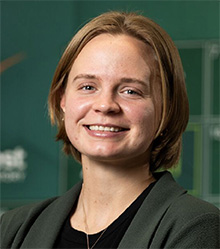
10:40 – 11:00 am CT, Location: Room 207
Presenter: Wilma Rishko
Summary: Redox flow batteries are a promising tool for long-term, stationary renewable energy storage. Aqueous organic redox flow batteries (AORFB) are a class of flow batteries that use safer and cheaper earth-abundant metals. Dihydroxyphenazine (DHP) is a candidate electrolyte for AORFBs with improved cycling stability, increased solubility, and higher cell voltage. We studied the transport properties of four different DHP isomers to understand how the molecular structure of these electrolytes affect important transport properties. We observed that the viscosity and aggregation of DHP generally increased as a function of concentration across all variants. Moving the hydroxyl functional group in the DHP alters the magnitude of aggregation and structure of clusters, which in turn affects transport properties in AORFBs. This study can provide a knowledge basis to design tailored organic electrolytes for flow batteries, especially when combined with machine learning schemes. READ MORE
Progress in Mass Spectrometry: Unambiguous Identification for Small Molecules Symposium
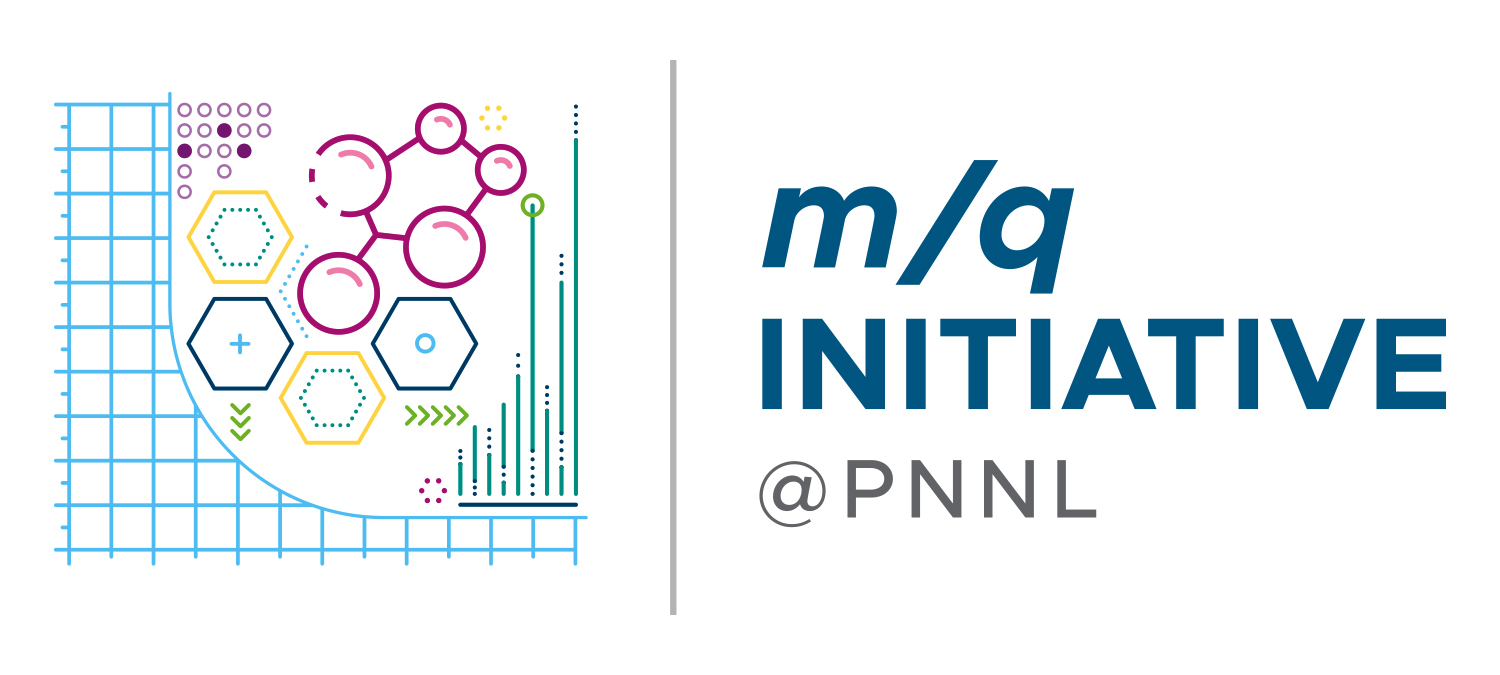
2:00 – 5:30 pm CT on Sunday and
8:00 – 11:30 am and 2:00 – 5:30 pm CT on Monday
Location: Room 350 (Sunday) and Room 351 (Monday)
Organizers: Robert Ewing, Yehia Ibrahim, Thomas Metz, Simone Raugei, Bobbie-Jo Webb-Robertson
Summary: The PNNL m/q Initiative is developing multi-dimensional and integrated experimental and computational methods to unambiguously identify small molecules without the need for authentic reference compounds. This initiative is hosting a symposium at ACS 2024 March 17-18 on the state-of-the-art in reference-free identification using mass spectrometry, featuring key leaders in the community. READ MORE
Monday, March 18
Fundamentals to Applications: Advances in Material-Based Hydrogen Storage for Energy and Industry: New Materials for Hydrogen Adsorption Storage
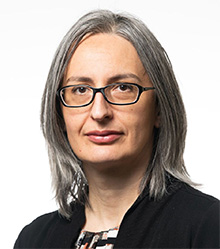
8:00 – 11:35 am CT, Location: Hall B, Room 12
Organizer: Bojana Ginovska
Summary: This symposium intends to bring together researchers from all fields relevant to developing the materials and chemistries that will facilitate transformative progress toward clean energy based on hydrogen storage, transportation, and other applications. We are specifically interested in research addressing materials development and characterization for solid and liquid H2 carriers, materials for long- and short-duration energy storage, catalysts for H2 interconversion, and methods and theory development for mechanistic studies of processes involved in H2-based chemistries. We encourage submissions from collaborative and interdisciplinary teams, including experimental, computational, and data-driven science. READ MORE
Hierarchical Assembly of Peptoids on van der Waals Materials

10:10 – 10:30 am CT, Location: Mardi Gras Ballroom, Salon B (New Orleans Marriott)
Presenter: Shuai Zhang
Summary: Biomimetic molecules have potential applications in molecular recognition, fabrication of bio-hybrid materials, energy conversion, and more. However, their capabilities to create and alter architectures have not been fully explored and documented. Peptoids are a class of biomimetic polymers similar to peptides, but with improved thermal and chemical stabilities. This talk presents recent achievements in assembling short peptoid oligomers on MoS2 and highly oriented pyrolytic graphite resolved by in-situ atomic force microscopy. By adjusting the pH of the assembly solution and the size of the hydrophobic side chains, we demonstrated that peptoid assembly could lead to diverse phases different from the bulk assembly of sheets and hollow spheres. We further found that 1) these phases can co-exist, 2) bulk-forming spheres could attach onto the peptoid film and further transition to lamellas, and 3) the lamellas could pack layer-by-layer to form ribbons. These results improve the knowledge of designing hierarchical architectures with biomolecules at solid-liquid interfaces. READ MORE
Integrating Generative AI with Computational Chemistry for Catalyst Design in Biofuel/Bioproduct Applications
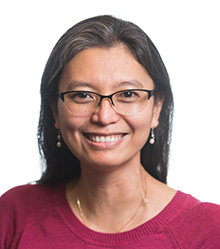
10:40 – 11:00 am CT, Location: Room R02
Presenter: Mariefel Olarte
Summary: Catalysts play a ubiquitous role in producing renewable fuels and chemicals to achieve worldwide NetZero goals. With the advent of AI for scientific discovery, new possibilities exist for using learned language representations to augment decision making during the catalyst design process. Our work focuses on integrating computational chemistry approaches, i.e., density functional theory (DFT), in a generative large language model (LLM) to identify the suitable catalytic descriptor and corresponding catalysts. ChemReasoner, our proposed system, provides an ability to intelligently search the scientific literature through LLM knowledge representation via feedback obtained from DFT simulation-guided machine learning models. Compared with the baseline single-prompt LLM output, our LLM model provides access to various novel catalyst structures (e.g., metal alloys) with favorable adsorption energy to facilitate the target reaction. READ MORE
Role of Palladium Oxide as Active Site in Pd/C Catalysts for Formate Dehydrogenation
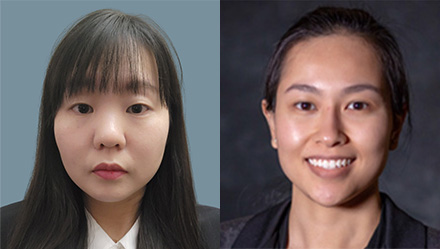
12:00 – 2:00 pm CT, Location: Hall C
Presenter: Mi Yeon Byun
Contributor: Thuy Le
Summary: Aqueous formate salts are being investigated as potential liquid organic hydrogen carriers to store and transport hydrogen, providing opportunities for long-duration energy storage. Palladium has been identified as a good metal for both selective hydrogenation and dehydrogenation. Our experimental studies with Pd/C catalysts have shown a direct correlation of the rates of H2 uptake and release with the presence of PdO in the carbon-supported catalysts. Our presentation will describe the preparation of Pd/C catalysts by chemical-reduction methods using different carbon supports: VC (Vulcan carbon), g-C3N4, and N-doped carbon. The Pd/VC catalyst calcined at 250 °C for 2h produced more PdO species and exhibited the highest performance in formate dehydrogenation, suggesting PdO as the active site. However, the Pd/g-C3N4 catalyst showed better stability after 4 cycles of batch reaction, demonstrating that carbon-support properties can affect the reducibility of Pd under formate dehydrogenation conditions. READ MORE
Accelerating Scientific Discovery with HPC and AI Presented by Microsoft Corporation
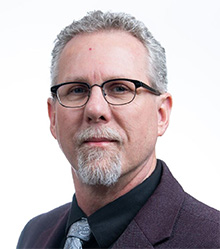
1:30 – 2:20 pm CT, Location: Hall D/E, Expo Theater 2
Presenter: Karl Mueller
Summary: Carbon capture and storage (CCS) strategies are crucial for reducing greenhouse gas emissions from major emitters, but traditional carbon capture techniques have high energy demands and extensive water consumption. This talk will highlight a pioneering shift in carbon capture technologies, the development and deployment of water-lean solvents for carbon dioxide capture. These new solvents represent a major leap in CCS technology with minimal water content that significantly enhances sustainability and cost-effectiveness. Water-scarce solvents can also be integrated with alternative carbon capture strategies, such as solid adsorbents, membrane processes, and cryogenic methods. The goal of this talk is to provide a perspective on the latest advancements and prospective trajectories in carbon capture technologies, emphasizing the contribution of water-lean solvents to sustainable and cost-effective CO2 sequestration methods. READ MORE
Mechanistic and Reactivity Studies of Copper-Hydride Monomer, Dimer, and Clusters

4:20 – 4:40 pm CT, Location Room 238
Presenter: Ba Tran
Summary: Understanding the role nuclearity and aggregation of metal sites on reactivity is central to homogeneous and heterogenous catalysis. Among metal-hydride systems, the chemistry of copper hydride has gained significant interest in the conversion of carbonyl compounds and unsaturated hydrocarbons. We conducted kinetic analysis to elucidate the fundamental mechanism of hydride transfer from a series of [(NHC)CuH]2 dimers to various carbonyl compounds and unsaturated hydrocarbons. The results of these studies have enabled the design of N-heterocyclic carbene ligands that can accelerate the insertion rate of substrate and access new reactivity. The isolation of an elusive (NHC)CuH monomer has also allowed for kinetic analysis to understand the early stages of monomer aggregation and cluster disaggregation. READ MORE
Multiscale Computational Modeling of Evaporation and Reactivity in Acetonitrile-Water-Amino Acid Droplets for Electrospray Ionization
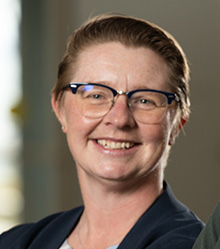
4:25 – 4:55 pm CT, Location: Room 351
Presenter: Samantha Johnson
Summary: Mass spectrometry can be applied to determine the identity and structure of single compounds or complex mixtures. We are developing computational approaches to understand and predict how matrix effects regulate the ionization fate of analytes. Our efforts focus on the reactive environment in droplets created during electrospray ionization (ESI). We divide the process of electrospray into continuum and atomistic regimes, as a function of size of the droplet. To simulate the initial processes within ESI and predict analyte concentrations within large droplets, we are developing an electrohydrodynamic model. In the intermediate region, molecular dynamics are used to probe the kinetics of droplet interface formation and interfacial reactions. We show that systems with mixtures of acetonitrile, water, and amino acids lead to enrichment of amino acids at the surface of the droplet. For the smallest droplets, we use density functional theory to probe ionization propensity of amino acid analytes, and microsolvated cluster energetics and structures. We show that the evaporation rate of the droplets is sensitive to the constituent concentrations, droplet size, and temperature. READ MORE
The Kavli Foundation Emerging Leader in Chemistry Lecture: The Many Flavors of Carbon Capture Technologies

5:00 – 6:00 pm CT, Location: La Nouvelle Orleans Ballroom
Keynote Presenter: Deepika Malhotra
Summary: Carbon capture and storage (CCS) strategies are crucial for reducing greenhouse gas emissions from major emitters, but traditional carbon capture techniques have high energy demands and extensive water consumption. This talk will highlight a pioneering shift in carbon capture technologies, the development and deployment of water-lean solvents for carbon dioxide capture. These new solvents represent a major leap in CCS technology with minimal water content that significantly enhances sustainability and cost-effectiveness. Water-scarce solvents can also be integrated with alternative carbon capture strategies, such as solid adsorbents, membrane processes, and cryogenic methods. The goal of this talk is to provide a perspective on the latest advancements and prospective trajectories in carbon capture technologies, emphasizing the contribution of water-lean solvents to sustainable and cost-effective CO2 sequestration methods. READ MORE
Tuesday, March 19
Extreme-Scale Heterogeneous Inference with Large Language Models and Atomistic Graph Neural Networks for Catalyst Discovery

7:00 – 9:00 pm CT, Location: Hall C
Presenter: Mariefel Olarte
Summary: Finding the optimal combination of operating conditions, reactants, and catalysts is essential to discovering new energy-efficient fuels or lower-energy chemical conversion processes. The emerging capability of large language models (LLMs) to reason in human-comprehensible terms provides an opportunity to accelerate scientific discovery via autonomous reasoning. We have developed ChemReasoner, which implements an LLM-based heuristic search framework. ChemReasoner explores the search space of chemical compounds by using prior probabilities derived from an LLM to initiate the exploration and guides itself via reward obtained from the exploration process. We developed a new dataset with 120 reasoning queries targeting biofuels-focused catalyst development for this study. Our evaluations demonstrate that ChemReasoner significantly outperforms other state-of-the-art LLM-based reasoning approaches. It recommends catalysts with 1) structures with favorable adsorption energy profiles, 2) explanations with higher specificity, and 3) results in significantly fewer hallucinations. We will release our code and data as open-source to advance the software-hardware codesign for AI-enabled science. READ MORE
Intermediate and Disordered Phases in Natural Systems
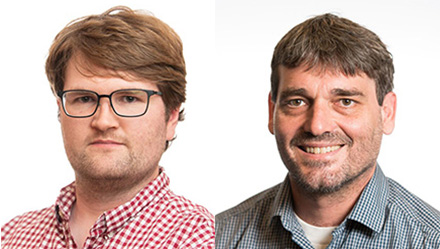
8:00 – 11:00 am and 2:00 – 4:30 pm CT, Location: Room 345
Organizers: Sebastian Mergelsberg, Micah Prange (presider)
Summary: The development of large-scale geochemical models requires understanding of key processes. The physical and chemical behaviors of natural systems are dominated by gradients that drive complicated material transformations. A recurring theme is the nucleation and growth of amorphous and disordered solids from initially homogeneous solutions. These materials present an interesting link between solute and crystalline states across the structural landscape. Current understanding of intermediate materials is emerging from rapid technical advances in instrumentation. Significant progress in atomistic simulations is providing atom- and molecular-level insight for systems with increasing amounts of disorder. The combination of computational and experimental methods has advanced our knowledge regarding the (geo)chemical significance of intermediate phases. This session is a forum to highlight experimental and theoretical progress unravelling bulk, nano, and/or interfacial structures and their associated reactivities. Topics of interest include but are not limited to mineral nucleation/growth, adsorption and transport at mineral interfaces, biomineralization, mineral reactivity, disordered structures, and particle-mediated growth phenomena. READ MORE
Enhanced Electrocatalytic Hydrogenation of Biomass-Derived Organics at Solid/Liquid Interface
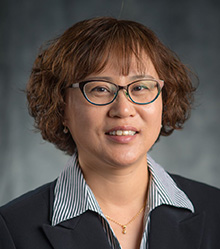
9:00 – 9:20 am CT, Location: Room 236
Presenter: Mal-Soon Lee
Summary: A major challenge in today's energy industry is eliminating the carbon and environmental footprint associated with petroleum use while meeting the growing demand for fuels, power, and chemical products. Electrocatalytic conversion of biomass-derived feedstocks is one of the most promising approaches to effectively recycle carbon from renewable energy resources. This requires the rational design of electrocatalysts with high activity and selectivity. Although electrocatalysis has been extensively studied, mechanistic investigation and molecular understanding of the electrochemical conversion of organic compounds specific to biomass feedstocks is lacking. We will address the effect of solvent and the charged metal electrode on the reaction pathways and their ability to undergo reduction/hydrogenation. Results of molecular-scale structural/electronic properties near the electrochemical interface and reaction energetics of target organic compounds obtained from density functional theory-based ab initio molecular dynamics simulations will be presented. The conclusions will be used for the postulation of design criteria for the electrocatalytic conversion of organic compounds from an experimental and theoretical perspective. READ MORE
Thursday, March 21
Structure Prediction for Sequence-Defined Polymers for Electron Transfer
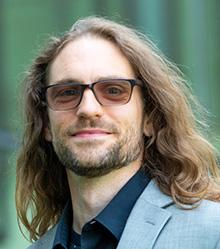
9:30 – 9:45 am CT, Location: Room R02
Presenter: Marcel Baer
Summary: The challenge of controlling electron transfer processes will be vital to meeting critical goals for energy supply and storage. Nature provides a blueprint for controlling the capture, storage, and transformation of energy through highly optimized redox protein complexes. Sequence-defined biomimetic polymers can replicate nature’s approach to energy transfer. Before recreating the multimeric complexes involved in the electron transfer, we need to understand and determine the local structures that define the redox center. We developed a methodology to sample the folding and binding space of short-chain polypeptides and polypeptoids to metal sites and determine optimized structures based on their redox potentials. Our structural prediction methodology was first evaluated on short polypeptide complexes with experimentally known redox potentials before being applied to screen more flexible polypeptoid sequences with unknown structures. This demonstrates the potential of this workflow to predict the local structure at redox sites for the future design of robust biomimetic polymer assemblies. READ MORE
For more information about physical and computational sciences at PNNL
Click on the flyers below to learn about our physical and computational sciences, including our mission, goals, achievements, and features of the Energy Sciences Center.
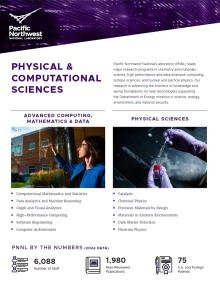 | 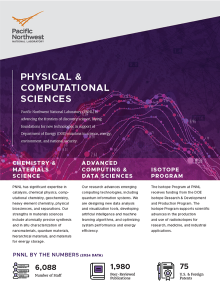 |
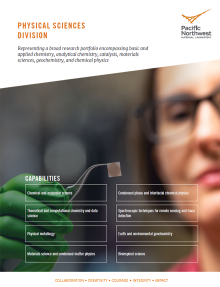 | 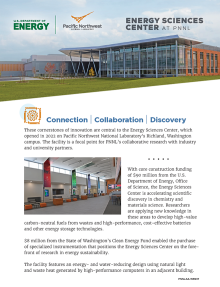 |